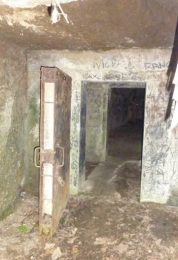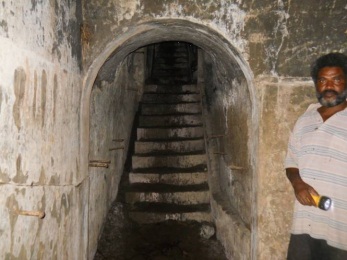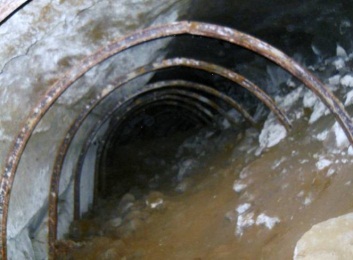Tunnel adventures in Rabaul: Rod Pearce




During the Japanese occupation of Rabaul in WWII, 300 to 500 kilometres of tunnels were dug into the volcanic soil around the Gazelle Peninsula and the caldera wall surrounding Rabaul Harbour. This was primarily to hide and protect the Japanese and their materials from Allied air-raids.
Most of the underground tunnels were dug during the period 1943 to early 1945. Many of the tunnels were dug by Indian, Korean, Indonesian and Chinese labour, captured in Malaysia, China and Singapore and transported to Rabaul. The majority of these were to die of disease, starvation, atrocities and overwork. The Japanese also used local Tolai labour from surrounding villages, as well as their own troops, who saw to the engineering and would at times work in the tunnels.
Allied POWs were also employed. Some 600 British POWs who surrendered at Singapore were transported to Rabaul and forced to work for the Japanese before being shipped to Ballale in the Solomons to construct an airfield. At war’s end in Rabaul, 18 were found alive from those transferred. POWs at Ballale did not survive.
The Japanese had many small forges and made a lot of their own tools. They were masters at getting the job done. In the early days most of the picks and shovels were brought in by ships from Japan and Singapore. The POWs used these. Pick and mattock marks can still be seen on the tunnel walls.
The removal of tailings from smaller tunnels was by using woven bamboo or coconut frond baskets. Also used was a two wheel, wheelbarrow. In larger systems small trolley carts on rails and even sleds pulled by the workers were utilised.
On the Gazelle Peninsula, 13 Army hospital complexes, housing over 4000 patients, were dug within 6 to 9 months. In the early days of 1942-43, before going underground, these hospitals took troops from Guadalcanal, Bougainville, Milne Bay, Buna/Kokoda and the New Guinea mainland.
The Navy also had two underground hospitals capable of 1000 patients each. At Gunanur the entrances were in a valley, with a small creek at the bottom which they had dammed to store water.
There was a small paddle wheel to lift and divert water inside the system. This system had blast doors and electricity, powered by an onsite generator. Insulators could still be seen anchored to the cement walls, however the wire had long gone, although pieces could still be seen protruding from the insulators. Some of the chambers of this system were three metres high, with other smaller chambers going off at right angles from the main passage way. Steps with hand rails were easily defined which lead to exits along the valley floor. The immense tonnage of overburden showed up as “excavations sites” with the lighter colour pumice showing up clearly against a jungle background. The Japanese hid the tailings by covering the piles with palm fronds.
I recently found a tunnel at the top end of Mango Avenue up against the caldera wall. Washed out in 2010, it had oil lamps and rotting wooden logs still in place, struggling to hold up the tunnel roof. At one stage electricity was used, as light bulbs were found bearing the Japanese characters and the Japanese “Anchor”, symbol of the Imperial Japanese Navy (IJN).
Most of the larger tunnels or those that were deemed necessary were shored up by timbers. Most of these have now rotted away although evidence can still be seen of the support beams. The design of the tunnels was usually the same with curved or arched ceilings on all small earthen tunnels.
The larger ones were usually used to house supplies. The cement ones were also built with rounded ceilings or with arched or flat ceilings complete with buttresses. Most were lit by coconut oil lamps. The more elaborate ones, such as command complexes, had electricity. The oil lamps were set into the walls of the tunnels in little recesses, just large enough to hold an oil lamp. Normally lighting was poor, as was ventilation, causing the system to be musty and damp.
The tunnels had at least two exit doors separate from the main entrance in case of accidental cave-ins from allied bombings. There were sometimes many passageways leading to underground chambers of various sizes for storage of ammunition, stores, sleeping quarters and also workshops as nothing could be done outside the system due to the frequent air raids. Most of them had exits close to AA positions or above ground installations.
Some of the larger tunnels were used to hide barges brought up on rails from the water 200 metres away. Up to five Japanese Daihatsu barges can still be seen inside a partly cemented tunnel on the road from Kokopo to Rabaul at the back of Vulcan. Other larger tunnels are at Blue Lagoon. These are huge tunnels, big enough to drive a truck into and were used as storage systems.
In a system close to the barge tunnels is a complete hospital, which covered three stories of tunnels along with tiled operating theatres, all dug into a near vertical wall of pumice, complete with stair cases and many chambers.
As a small boy growing up in Rabaul in the 50s, I remember the tunnels and most of the kids played in them. Rabaul then was a little boy’s delight. There are many tunnels within an easy walk of the Rabaul Hotel. The hotel also has its own underground bunker below the restaurant, now a pistol range. The New Guinea Club (now turned into a museum) has a deep cement bunker known locally as Yamamoto’s Bunker. There is a map of Simpson Harbour on the ceiling of the bunker.
There is a fascinating tunnel system at the top of Tunnel Hill and the road to the Volcano Observatory, where the “Kempi Tai” (Japanese Military Police) had their headquarters.
This is also where the Allied prisoners, few of whom survived the war, were quartered. Many references are found in books relating to the conditions of the POWs in the Tunnel Hill complex. Many died here from beatings, sickness and untreated wounds and the tunnels are a direct remainder of what they must have suffered.
At one complex opening, there is a system which not only housed the men and munitions, but was also used for cooking and even had a stream for water catchment. The stream can still be seen today.
Deeper underground via a spiral staircase carved into the pumice going down 30 metres, you will find the passages are long and wide enough to drive a small vehicle through. Above ground, a spectacular view overlooks both sides of the caldera, Watom Island to the North and Simpson Harbour and the Beehives to the south.
There are another three entrances. On the walls of this tunnel, you can clearly see the marks left by the digging tools. There are also six 75mm high-elevation AAs, all aimed skyward, slowly rusting under a canopy of palm trees.
On Namanula Hill, overlooking Simpson Harbour, we came upon several more tunnels, recently uncovered by the monsoonal rains. The entrances to these tunnels were concrete and had steel doors. On the first tunnel the doors had rusted away allowing us the opportunity just to look in. It was a small cement rendered cavern, going back no more than 20 feet. The end of it looked like it has been sealed off.
The next set of tunnels is further up the road. The road is now an overgrown track and about 12 feet above what is now Namanula road. The first entrance was well hidden under a mound of dirt. The concrete archway was just visible and we managed to crawl in backwards. This tunnel had a couple of corridors going off in different directions: some led to a dead end and others had had cave-ins where exits once existed.
These are the tunnels my brother and I explored endlessly, back in the 50s.


